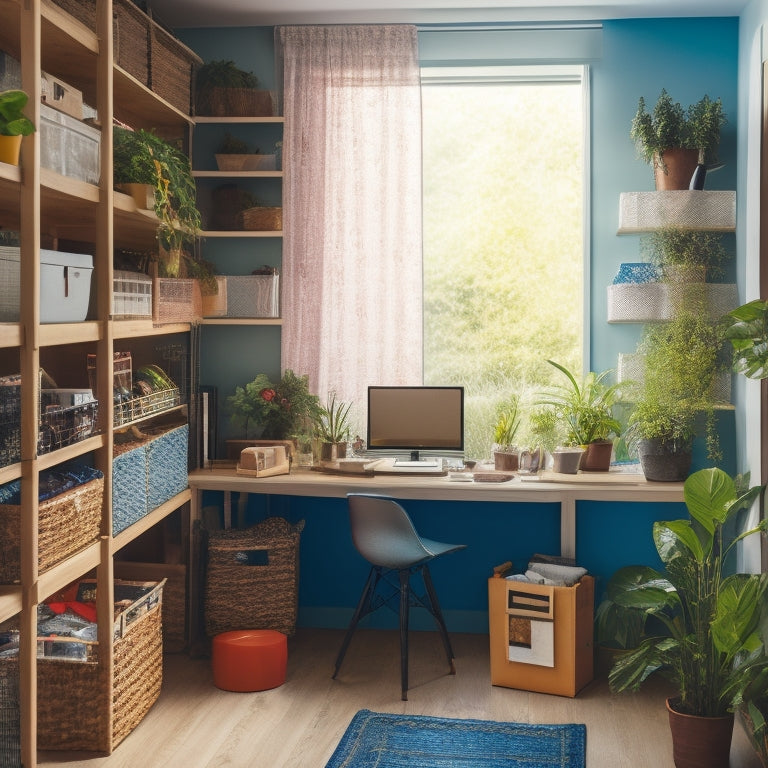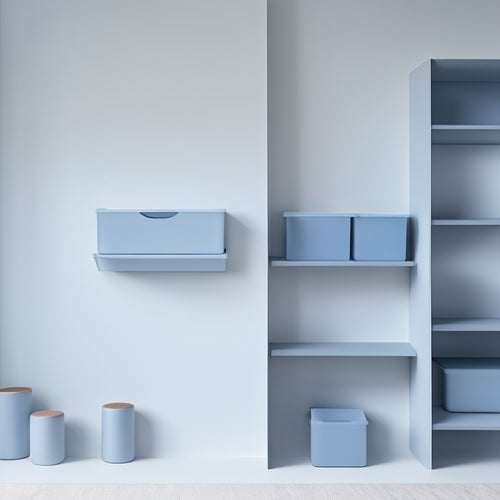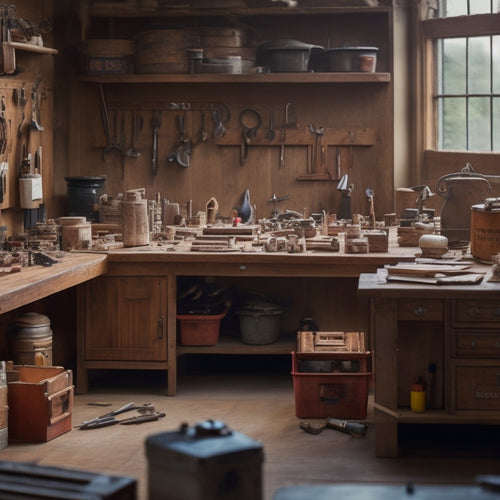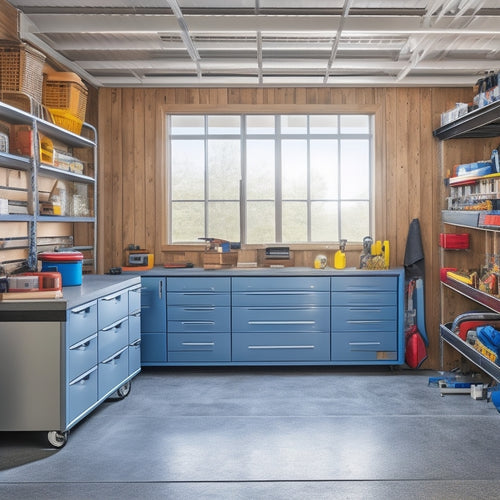
5 Ways to Maximize Space With Organized Storage Containers
Share
By implementing a well-organized storage system, you can maximize your available space by nearly 30%. To get started, optimize your shelves with stackable containers, utilizing vertical space with tall units, and label and categorize storage bins for easy identification. Choose multi-purpose storage solutions that offer flexibility and versatility, and designate zones for easy access to frequently used items. By following these 5 strategies, you'll be well on your way to creating a clutter-free and functional space - and there's even more to investigate to guarantee your storage system is customized to your unique needs.
Key Takeaways
- Use stackable containers to maximize shelf space, placing heaviest items at the bottom for stability and ensuring a snug fit on shelves.
- Implement vertical storage with tall units, utilizing corner spaces and adjustable shelving for flexibility and easy retrieval.
- Label and categorize storage bins by theme, using clear and readable labels, and store them based on frequency of use for easy access.
- Choose multi-purpose storage solutions, such as stackable crates and modular shelving units, to reduce clutter and enhance organization.
- Designate zones for easy access, categorizing items by frequency of use and grouping similar items together to minimize search time.
Optimize Shelves With Stackable Containers
When it comes to maximizing shelf space, stackable containers are a revolutionary innovation. By using these containers, you can efficiently store and organize your belongings while keeping your shelves clutter-free.
To get the most out of your stackable containers, it's vital to choose the right container materials. Look for durable, high-quality materials that can withstand the weight of the items you plan to store.
Effective stacking techniques are also important to optimize shelf space. Start by placing the heaviest items at the bottom and work your way up to the lighter items. This will prevent the containers from toppling over and guarantee your belongings remain safe.
Additionally, consider the size and shape of the containers to make sure they fit snugly on the shelf, leaving minimal gaps. By implementing these strategies, you can create a safe and organized storage system that makes the most of your shelf space.
Utilize Vertical Space With Tall Units
Five tall units can make a significant impact on your storage capacity, especially in rooms with high ceilings. By employing vertical space with tall shelving, you can optimize your room's layout and create a more organized environment. This is particularly useful for storing items that you don't frequently use, such as seasonal decorations or out-of-season clothing.
| Benefits | Tips |
|---|---|
| Maximizes storage capacity | Place tall units in corners to make use of dead space |
| Reduces clutter | Consider adjustable shelving for flexibility |
| Improves vertical organization | Install units that are sturdy and secure |
| Enhances room appearance | Choose units that match your room's aesthetic |
| Increases accessibility | Label shelves to guarantee easy item retrieval |
When selecting tall units, prioritize stability and durability to guarantee your safety. Look for units with sturdy frames and secure shelving to prevent accidents. By incorporating tall units into your storage strategy, you'll be able to create a more organized, efficient, and safe space.
Label and Categorize Storage Bins
Three storage bins can quickly turn into thirty if you don't have a system in place. To avoid this chaos, it's crucial to label and categorize your storage bins. This will help you quickly identify what's inside each bin, making it easier to find what you need and preventing clutter from building up.
When labeling your bins, consider the following:
-
Color coding: Use different colored labels or bins to categorize items by theme, such as seasonal decorations or cleaning supplies.
-
Label styles: Choose labels that are easy to read and understand, and consider using images or icons for bins that hold items used by multiple people.
-
Bin placement: Store bins in a way that makes sense for your needs, such as placing frequently used items in easy-to-access locations.
Additionally, consider the material choices and bin sizes you use, as well as the accessibility features of your bins.
Choose Multi-Purpose Storage Solutions
Across various rooms and spaces, you've likely accumulated a mix of storage containers, each serving a specific purpose. However, having multiple containers can lead to clutter and disorganization. To maximize space and efficiency, consider choosing multi-purpose storage solutions that can adapt to different needs.
| Storage Solution | Features |
|---|---|
| Stackable Crates | Flexible designs, adjustable compartments, and easy stacking for optimized storage |
| Modular Shelving Units | Aesthetic appeal, customizable configurations, and adjustable shelves for various item sizes |
| Convertible Storage Ottomans | Dual-purpose design for storage and seating, with removable lids and compartments |
These multi-purpose storage solutions offer flexibility and versatility, allowing you to store a variety of items while maintaining a clutter-free space. By incorporating flexible designs and aesthetic appeal, you can create a safe and functional storage system that meets your specific needs. By doing so, you'll be able to optimize your storage space, reduce clutter, and maintain a sense of organization and control.
Designate Zones for Easy Access
Now that you've chosen multi-purpose storage solutions, it's time to think about how you'll organize the items you're storing. A vital step in maximizing space is designating zones for easy access. This involves creating clear zone boundaries and access paths to guarantee you can quickly find what you need.
To create effective zones, follow these guidelines:
-
Categorize items by frequency of use: Store items you use daily in easy-to-reach zones, while less frequently used items can be stored in harder-to-reach areas.
-
Group similar items together: Store related items, such as cleaning supplies or office materials, in the same zone to reduce searching time.
-
Leave space for movement: Confirm your access paths are wide enough for you to comfortably move through the space, reducing the risk of accidents or injuries.
Frequently Asked Questions
How Do I Prevent Containers From Looking Cluttered or Messy?
When arranging storage containers, you'll prevent clutter by implementing a consistent labeling system and choosing container sizes that fit the items they'll hold, ensuring a tidy and organized appearance that promotes safety and ease of use.
Can I Use Storage Containers in Humid or Damp Areas?
You wouldn't think to store precious items in a damp basement, but with humidity-resistant containers, you can! Look for containers made from materials like plastic, stainless steel, or rust-proof metals to guarantee your belongings stay safe and dry.
Are Clear Storage Bins Better Than Opaque Ones?
You'll find clear storage bins offer clear visibility, making it easier to spot what's inside, and they often have an aesthetic appeal that opaque ones lack, but consider your needs and the environment you're storing in before making a decision.
How Often Should I Clean and Dust Storage Containers?
You should clean and dust storage containers every 2-3 months to prevent dust buildup and pest infestations. Develop a routine to wipe down containers with a damp cloth and dust with a microfiber cloth to maintain a safe and organized space.
Can I Use Storage Containers Outdoors or in Extreme Temperatures?
You'll want to check the storage container's outdoor durability and temperature resistance before placing it outside or in extreme temps. Look for weather-resistant materials, UV protection, and temperature ratings to guarantee your container can withstand the conditions.
Conclusion
As you step into your newly organized space, imagine the sense of calm that washes over you. The clutter is gone, replaced by a sense of control and clarity. Your belongings are no longer scattered, but instead, neatly tucked away in their designated homes. You can breathe easier, think clearer, and focus on what matters most. With these 5 strategies, you've created a haven of efficiency, where every item has its place, and every moment is a chance to thrive.
Related Posts
-

Small Storage Bins to Maximize Shelf Space
When maximizing shelf space, you want to make the most of every inch. Small storage bins are the answer, but choosing...
-

Top 7 Parts Tray Organizers for Productivity
You can optimize your workspace and enhance productivity with the right parts tray organizer, which can help you cate...
-

Top Rolling Tool Box Drawers for Maximum Storage
When it comes to maximizing storage with rolling tool box drawers, you need a solution that combines durability, cust...


